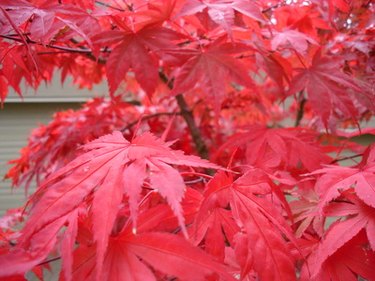
The Japanese Maple is a member of the maple family, which as the name suggests, originated in Japan. They are known most frequently by the vivid colors that the leaves produce during the cool fall months. There are hundreds of different varieties of Japanese Maple trees, but there are only a few major types separated by color and leaf design. One you identify the major type of Japanese Maple, it is much easier to identify the name of the one you have.
Step 1
Examine the color of your Japanese Maple tree's leaves in the fall. The red leaf variety of Japanese Maple has leaves that turn red in the fall, while the green leaf variety has leaves that turn yellow or orange.
Video of the Day
Step 2
Determine if your tree is a whole-leaf or cut-leaf variety. Whole-leaf Japanese Maple trees produce leaves with solid surfaces that have an irregular border along the edges. Cut-leaf Japanese Maples, also called lace-leaf, have a lacy or feathery look with no flat surface. Each leaf is a series of feather-like projections that reach to the base of the leaf itself.
Step 3
Look at the overall appearance of the tree to determine if it is an upright or weeping variety. An upright tree grows straight, like most other maples; the branches are very rigid, even in young plants. The weeping variety's limbs bend toward the ground, creating a waterfall or weeping effect. The limbs of these varieties are less rigid and have a flexible feel.
Step 4
Measure the height of the Japanese Maple tree. A Japanese Maple that stops growing at six feet is classified as a dwarf variety.
Step 5
Narrow down the exact name of your Japanese Maple by comparing the information regarding color and leaf type to classification catalogs. One such classification listing is provided in the Resources section, although there are many others online and in book format.
Video of the Day